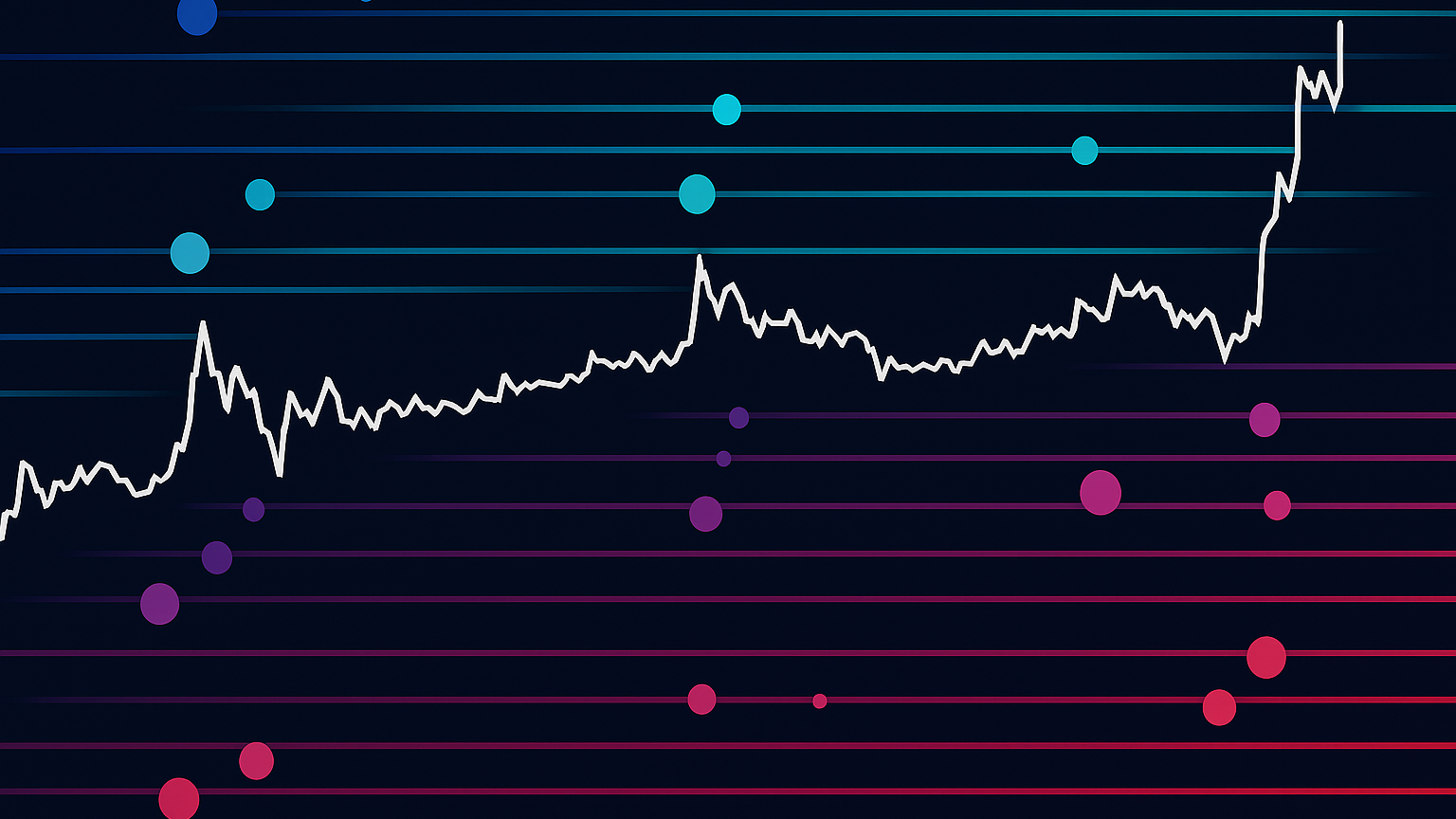Learn how to leverage volume analysis for high-volatility breakouts, enhancing trading strategies with reliable indicators and risk management techniques.
Volume is essential for identifying high-volatility breakouts in trading. A breakout with high volume indicates strong market participation, increasing the chances of sustained price movement. Low-volume breakouts, on the other hand, often fail. Here's how volume can guide your trading decisions:
- Confirm Breakouts: High volume during breakouts signals reliability; low volume may indicate false moves.
- Spot Trends: Tools like VWAP and ATR help combine volume and volatility for better breakout detection.
- Key Patterns:
- Rising volume + price breakout = strong momentum.
- Volume spikes = potential trend shifts.
- Volume divergence = caution for reversals.
Quick Tips:
- Look for volume spikes (200%+ above average) during breakouts.
- Use tools like Bollinger Bands and ATR to measure volatility.
- Manage risk with stop-losses below breakout levels.
Platforms like LuxAlgo provide advanced volume tools to simplify analysis and improve breakout strategies.
Volume's Impact on Breakouts
Volume is a key indicator of market strength and conviction, especially when confirming breakouts during volatile conditions. It helps traders separate meaningful price moves from minor fluctuations, which is crucial in markets where price action can be unpredictable.
Volume Patterns and Breakout Analysis
In volatile markets, volume acts as an important tool for validating breakouts. The interaction between price and volume can reveal how reliable a breakout might be:
| Volume Pattern | Breakout Interpretation |
|---|---|
| Rising Volume + Price Breakout | Indicates strong market interest, increasing the chance of sustained movement. |
| Declining Volume + Price Breakout | Suggests weaker momentum, raising the likelihood of a failed breakout. |
| Volume Spike | Shows heightened interest, often signaling a potential trend shift. |
When price and volume move in opposite directions, known as volume divergence, it can signal trouble. For instance, if price breaks to a new level but volume decreases, this often points to weakening momentum and a higher chance of a reversal [1]. Traders should treat such divergence as a cautionary signal when managing breakout trades.
Relative volume is another useful metric. It compares current trading activity to the volume during the prior consolidation phase. A breakout accompanied by volume at least twice the average often reflects strong market interest, boosting the odds of a successful breakout [5].
Spotting High Volatility Breakouts
Identifying high volatility breakouts involves blending volume analysis with volatility indicators to pinpoint the best opportunities.
Tools to Measure Volatility
Using tools like Bollinger Bands and ATR (Average True Range) can help spot potential breakout moments. Here's how they work:
| Tool | Purpose | Breakout Signal |
|---|---|---|
| Bollinger Bands | Tracks price volatility | A squeeze signals a potential breakout |
| ATR | Measures the range of price movement | Rising ATR points to increasing volatility |
| Volume Analysis | Confirms price action | A volume spike validates the breakout |
These tools complement each other, but volume confirmation is key to ensuring a breakout is genuine.
How to Spot Volume Spikes
True breakouts are usually accompanied by sharp volume increases, showing strong market interest. Look for these volume patterns:
- Consolidation Phase: Volume decreases as prices consolidate.
- Breakout Moment: Volume doubles (or more) compared to recent levels.
- Follow-through: Sustained high volume after the breakout.
Pairing volume analysis with technical indicators like Bollinger Bands can help you avoid false signals. For example, when price breaks through the bands during a squeeze, a matching volume spike can confirm the breakout's strength.
Understanding these patterns is just the start - combining them with well-thought-out strategies can lead to more effective trading decisions.
Strategies for Trading High Volatility Breakouts
Using VWAP for Breakout Confirmation

The Volume-Weighted Average Price (VWAP) is a handy tool for confirming breakouts, as it combines price and volume to show the market's real value. Traders often rely on VWAP signals to make informed decisions during breakout scenarios:
| VWAP Signal | Trading Action | Risk Management |
|---|---|---|
| Price breaks above VWAP + volume spike | Look for a long position | Place a stop-loss just below VWAP |
| Price holds above VWAP | Continue holding the position | Adjust stop-loss as the price moves upward |
| Price breaks below VWAP | Consider exiting or reversing the trade | Secure profits with a stop-loss |
When the price pushes past resistance and stays above the VWAP, it often indicates strong buying momentum, suggesting the trend may continue. While VWAP offers useful confirmation, keeping a close eye on risk is just as important in these volatile situations.
Managing Risk in Breakout Trading
Effective risk management is key to trading breakouts. Limit your trade risk to 1-2% of your capital, adjust position sizes to account for volatility, and set stop-losses slightly below breakout levels using tools like the Average True Range (ATR). Aim for a risk-reward ratio of at least 1:2 by targeting profits at previous swing highs or lows.
High-volume breakouts often point to sustained price movements due to increased market participation. Tools like LuxAlgo’s volume indicators can help traders spot genuine volume surges and avoid false breakouts. By combining these methods with an understanding of volatility patterns, traders can create a balanced strategy that captures opportunities while managing risks effectively.
Tools for Volume-Based Breakout Trading
LuxAlgo: Trading Indicators and AI Tools

LuxAlgo offers a range of tools designed to simplify volume-based breakout trading . Here's a quick breakdown of its main features:
| Feature | How It Helps |
|---|---|
| Volume Analysis Toolkit & AI Backtesting | Spot volume patterns and test strategies using historical data. These insights work best when used alongside other indicators such as ATR, Bollinger Bands, or VWAP. |
| Custom Alert System | Receive alerts when trading volume surges or meets specific criteria, helping traders monitor potential breakout conditions. |
While LuxAlgo provides advanced analytics to complement your trading, there is no single “volatility breakout” tool that automatically generates trade setups. Instead, use LuxAlgo’s indicators to augment your current strategies—such as identifying volume spikes in conjunction with Bollinger Band squeezes or VWAP breakouts. By blending LuxAlgo’s insights with reliable risk management and established technical signals, traders can improve their breakout detection and reduce false alarms.
Examples of High Volatility Breakouts with Volume Analysis
Stock Breakout Example
Consider a stock that broke above $60, with a massive 800% surge in volume, reaching 400,000 shares. This sharp increase in activity signaled strong buyer interest, likely driven by institutional players. Before the breakout, the stock traded in a range of $50 to $60 for several weeks, with an average daily volume of just 50,000 shares [1].
| Breakout Characteristics | Data |
|---|---|
| Price Range Before Breakout | $50-$60 |
| Average Daily Volume | 50,000 shares |
| Breakout Volume | 400,000 shares |
| Volume Increase | 800% |
| Resistance Level | $60 |
This clear volume pattern highlights the role of institutional interest in stock breakouts. However, crypto markets bring their own set of complexities due to their extreme price swings.
Crypto Market Breakout Case Study
In the crypto space, tools like LuxAlgo's volume analysis can help traders spot breakout opportunities. Key signals to watch for include:
- A period of low volatility and consolidation
- A price move breaking above resistance levels
- A volume spike exceeding 200%, followed by sustained momentum
Effective trading in these markets requires pairing volume analysis with solid risk management. For example, setting stop-losses just below the breakout level can protect against false signals while allowing traders to lock in gains. Using tools like ATR (Average True Range) for stop-loss placement can further refine this strategy [1][4].
These cases show how volume analysis can be a powerful tool for improving breakout trading strategies, whether in stocks or crypto.
Conclusion: Using Volume for Successful Breakouts
Analyzing volume is key to confirming breakouts during periods of high volatility. When you see volume spikes — 200% or more above the average — it often indicates strong market interest and increases the likelihood of a successful breakout [1][3]. Pairing volume analysis with tools like Bollinger Bands or ATR can improve the accuracy of breakout identification, while solid risk management strategies help protect your capital and optimize returns [1][4].
Here’s how to apply volume-based breakout strategies:
- Track Volume Changes: Look for sharp increases in volume during breakouts, as this signals active market participation and confirms price movements.
- Use Technical Indicators: Combine volume analysis with Bollinger Bands and ATR to spot periods of low volatility, which often precede breakouts [2][4].
- Prioritize Risk Management: Set stop-loss orders just below breakout levels and adjust position sizes based on volatility [1][4].
Modern tools make volume analysis easier than ever. For instance, LuxAlgo offers advanced features like volume pattern detection, AI-driven insights, and other indicators to quickly identify promising setups. These tools help traders integrate traditional analysis techniques with cutting-edge technology for real-time application.
Volume divergence also plays a crucial role in spotting trend reversals. By staying focused on these signals and leveraging modern tools alongside consistent strategies, traders can navigate even the most volatile markets with confidence.
FAQs
How Does Volume Confirm Breakouts?
Breakouts are confirmed when there's a 200%+ increase in trading volume, showing strong market interest [1][3]. For instance, a breakout with low volume often signals a false move, while high-volume breakouts indicate genuine buying activity.
Key signs to watch for include:
- A volume surge during the breakout
- Consistently high volume after the breakout
- Increased volume during breakout retests
To improve accuracy, pair volume analysis with tools like VWAP or Bollinger Bands. This helps confirm breakout strength and reduces the chances of falling for false signals [1][4]. LuxAlgo offers tools that make volume analysis easier, helping traders identify reliable breakout patterns.
Volume trends can offer valuable insights into price action:
- Rising prices with growing volume point to a strong uptrend
- Weak volume during price increases may signal a weakening trend
- High volume when breaking resistance confirms the breakout's validity [3]
Volume analysis is most effective when used as part of a broader strategy. Combining it with technical tools and solid risk management, as mentioned earlier, creates a more reliable approach to breakout trading [1][3].
References
- VWAP (Investopedia)
- ATR (Wikipedia)
- Bollinger Bands (Wikipedia)
- LuxAlgo
- IG.com - Breakout Volume & Volatility
- Trading Breakouts with Better Edge
- Range Breakout Signals (LuxAlgo)
- Technical Indicators (LuxAlgo Blog)
- VWAP Signals (LuxAlgo)
- Trading Strategies (LuxAlgo Blog)
- Volume-Based Breakout Trading (LuxAlgo Docs)
- Volume Analysis Toolkit (LuxAlgo)
- 5 Trading Strategies for Volatile Markets (Blueberry Markets)
- Volatility Breakout Trading Strategy (Traders Mastermind)
- Trend Reversals (LuxAlgo Docs)
- Why Trading Volume Is Important (Investopedia)
- Breakouts with Tests/Retests (LuxAlgo)







